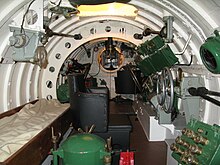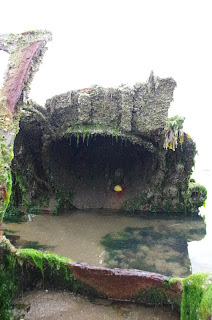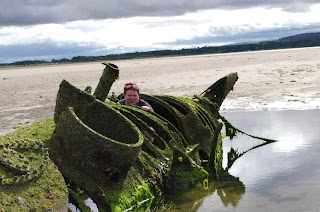Aberlady Bay , East Lothian has a number of remarkably little known historic wrecks including two midget submarines, Royal Naval X-craft. They were training versions (X-T craft) of the type that attacked the German battleship Tirpitz in Kaafjord. This operation was launched from Scotland where much of the training of midget submarine and human torpedo (Chariot) crews had been carried out. In 1993 the Chariots Trust erected a memorial at Kylesku on Loch Cairnbawn to the operators of His Majesty’s X-craft and human torpedoes.
In 1946 two X-TS were moored on the vast expanse of sand at Aberlady as targets for aircraft gunnery practice. The distinguished war record of allied and axis miniature submarines in attacking harbours and shipping was a driver of post war maintenance of anti-submarine capability, especially covering the approaches to Royal Naval bases like Rosyth.
The X class was a World War II midget submarine class built for the Royal Navy during 1943–44.

Known individually as X-Craft, the vessels were designed to be towed to their intended area of operations by a full-size 'mother' submarine - (usually one of the T class or S class) - with a passage crew on board, the operational crew being transferred from the towing submarine to the X-Craft by dinghy when the operational area was reached, the passage crew returning with the dinghy to the towing submarine. Once the attack was over, the X-Craft would rendezvous with the towing submarine and then be towed home. Range was limited primarily by the endurance and determination of their crews, but was thought to be up to 14 days in the craft or 1,500 miles (2,400 km) distance after suitable training. Actual range of the X-Craft itself was 500 nmi (930 km) surfaced and 82 nmi (152 km) at 2 knots (3.7 km/h) submerged.
The craft was about 51 feet (15.5 m) long, 5.5 feet (1.68 m) in maximum diameter and displaced 27 tons surfaced and 30 tons submerged. Propulsion was by a 4-cylinder Gardner 42 hp diesel engine, converted from a type used in London buses, and a 30 hp electric motor, giving a maximum surface speed of 6.5 knots (12 km/h), and a submerged speed of 5.5 knots (10.1 km/h). The crew initially numbered three—commander, pilot and ERA (Engine Room Artificer, i.e. engineer) but soon a specialist diver was added, for which an airlock, known as a wet and dry compartment, was provided. The ERA, usually a Navy Chief Petty Officer, operated most of, and maintained all of, the machinery in the vessel.
The weapons on the "X-Craft" were two side-cargoes - explosive charges held on opposite sides of the hull with two tons ofamatol in each. The intention was to drop these on the sea bed underneath the target then escape. The charges weredetonated by a time fuse.
The craft were fitted with electro-magnets to evade detection by anti-submarine detectors on the sea bed.
A number of development craft were built before it was felt that a realistic weapon had been produced. The first operational craft was HMS X3 (or HM S/M X.3), launched on the night of March 15, 1942. Training with the craft began in September 1942, with HMS X4 arriving in October. In December 1942 and January 1943 six of the "5-10" class began to arrive, identical externally but with a completely reworked interior.
These operations were part of a longer series of frogman operations, see human torpedo.
Their first deployment was Operation Source in September, 1943, an attempt to neutralise the heavy German warshipsbased in Northern Norway. Six X-Craft were used, but only 2 successfully laid charges (under the German battleshipTirpitz); the rest were lost, scuttled or returned to base. The Tirpitz was badly damaged and out of action until April 1944.
This was the only multiple X-craft attack. The lost craft were replaced early in 1944 with X20 to X25 and six training-only craft.
On April 15, 1944 HMS X24 attacked the Laksevåg floating dock at Bergen. X22 was intended for the mission, but had been accidentally rammed during training and sunk with all hands. The X24 made the approach and escaped successfully, but the charges were placed under the Bärenfels, a 7,500 ton merchant-vessel along the dock, which was sunk; the dock suffered only minor damage. On September 11, 1944 the operation was repeated by X24, with a new crew; this time the dock was sunk.
X-Craft were involved in the preparatory work for Overlord. Operation Postage Able was planned to take surveys of the landing beaches with HMS X20 spending four days off the French coast. Periscope reconnaissance of the shoreline and echo-soundings were performed during daytime. Each night, X20 would approach the beach and 2 divers would swim ashore. Soil samples were collected in condoms. The divers went ashore on two nights to survey the beaches at Vierville-sur-Mer, Moulins St Laurent and Colleville-sur-Mer in what became the American Omaha Beach. On the third night, they were due to go ashore off the Orne Estuary (Sword Beach), but by this stage fatigue (the crew and divers had been living on little more than benzedrine tablets) and the worsening weather caused Hudspeth to shorten the operation, returning to Dolphin on 21 January 1944. Hudspeth received a bar to his DSC.
X20 and X23 acted as lightships to help the D-Day invasion fleet land on the correct beaches (Operation Gambit), as part of theCombined Operations Pilotage Parties (COPP).
X24 is the only remaining intact example of an X-Craft. It can be found in the Royal Navy Submarine Museum.
Operations continued in the Far East with the revised XE class submarines
X-craft and crews

- X3 — was lost on 4 November 1942 in Loch Striven due to a leaking engine valve. All crew escaped by utilizing their Davis Submerged Escape Apparatus.[1]
- X5 — unofficially named Platypus,[2] commanded by Lt. Henty-Creer RNVR (also the operation's commander),[3] crew S-Lt. Nelson, Midshipman Malcolm, and ERA Mortiboys; passage crew Lt Terry-Lloyd (commanding), L/S Element, Stoker Garrity.[4] Henty-Creer, Nelson, Malcolm, and Mortiboys were killed in the attack, though X5's exact fate is unknown.[4]
- X6 — named Piker II,[3] commanded by Lt. Donald Cameron, crew Lt. J. T. Lorimer, S-Lt. R. Kendall, and ERA Goddard; passage crew Lt Wilson (commanding), Leading Seaman McGregor, Stoker Oxley.[3] Cameron earned a VC, Lorimer and Kendall DSOs, Goddard a Conspicuous Gallantry Medal.[3]
- X7 — unofficially named Pdinichthys,[5] commanded by Lt. Basil C. G. Place, crew S-Lt. R. Aitken, Lt. Whittam, and ERA Whiteley; passage crew Lt Philip (commanding), Leading Seaman J. Magennis, Stoker Luck.[3] Vessel was scuttled immediately following the Tirpitz attack, but only Place escaped before she sank. Aitken escaped from the bottom of the fjord, but Whittam and Whiteley were unable to escape before their air gave out. Place also earned a VC, Aitken a DSO, while Philip earned an MBE;[6]
- X8 — commanded by Lt. McFarlane RAN[3] (Lt. Smart was passage crew commander)
- X9 — commanded by Lt. E. A. Kearon RNVR; A.H. Harte (Able Seaman) and G. H. Hollet (Stoker). X9 was unofficially named Pluto
- X10 — unofficially named Excalibur,[7] commanded by Lt. Hudspeth RANVR[3]

The cruising yachtsman entering harbours on the surface can only imagine the navigational difficulties of the X-craft in wartime blackout. The achievements of the diver, going out to cut through anti submarine netting, place explosive charges and carry out reconnaissance as they did for the D-Day landings were even more amazing. Description of X-craft operations and the part played by the divers can be found in The Frogmen by Waldron and Gleeson (6). This book has a photograph of an X-craft on the surface in which detail of the free flooding casing can be seen. This title and Above us the Waves also describe Chariots, human torpedoes crewed by frogmen wearing breathing apparatus. Like X-craft they have Scottish connections and had been used in an earlier attack on the Tirpitz, supported by the Shetland Bus (7&8).Walking back to the car park I noticed numerous timber stumps in the sand. Some are the remains of wartime anti-landing poles, placed to deter the landing of troops by glider. Certainly at low water this firm sand would have made a good landing zone. In May 1940 a coup de main party of German glider borne troops had taken the Belgian strong point of Eben Emael on the Albert canal, a dramatic demonstration of the potential of airborne forces not lost on the UK high command. This and other German successes with airborne troops early in the war had spread fear of airborne invasion and Aberlady beach had become a forest of anti-landing poles. Higher up the shore one can also see concrete pyramids forming tank barriers.
The best WWII submarine film of all-time, Wolfgang Petersen’s “Das Boot”, comes closest to conveying the discomfort and terror of submarine warfare but U96 was spacious compared to an X-craft.
References
1. Shipwrecks of the Forth , Bob Baird, Nekton Books, 1993, ISBN 897995 00 8.
2. Above us the Waves, C.E.T. Warren and James Benson, George Harrap and Co. Ltd., 1953 with a forward by Admiral Sir George Creasy.
3. Damned Un-English Machines, A history of the Barrow built submarines, Jack Hool & Keith Nutter, Tempus, 2003.
4. Royal Naval Submarine Museum , Haslar Jetty Road . Gosport , Hants , PO12 2AS . www.rnsubmus.co.uk
5. Undersea warfare website: http://www.chinfo.navy.mil/navpalib/cno/n87/usw/issue_19/royal_navy2.htm
6. The Frogmen, T.J. Waldron and James Gleeson, Evans Bros Ltd, 1950 and by Pan Books 1954, New Edition 1965.
7. The Shetland Bus, David Howarth, Thomas Nelson and Sons Ltd, 1951 and other imp res sions.
8. None but the Brave, Frithjof Saelen, Souvenir P res s, 1955, The Elmfield P res s, 1974, ISBN 0 7057 0053 4.
9. Collins Pocket Guide to the Sea Shore , John H Barrett and CM Yonge, 1958,
10. Film- UK History ChannelWikipedia
http://en.wikipedia.org/wiki/Aberlady_Bay
http://en.wikipedia.org/wiki/X_class_submarine
http://www.giemmesesto.org/ModelliSoci/Sottomarini/Xcraft.html













Hi, great to see another blog post on the XT subs!,
ReplyDeleteI visit them every other weekend when out on the beach cycling and i am always in awe at these tiny craft and the nerves of steel their crews must have had.
Nice post,
Bruce (coastkid)
O, tam mnie jeszcze nie bylo, ale wybieram sie;) Wyglada to super;)
ReplyDelete